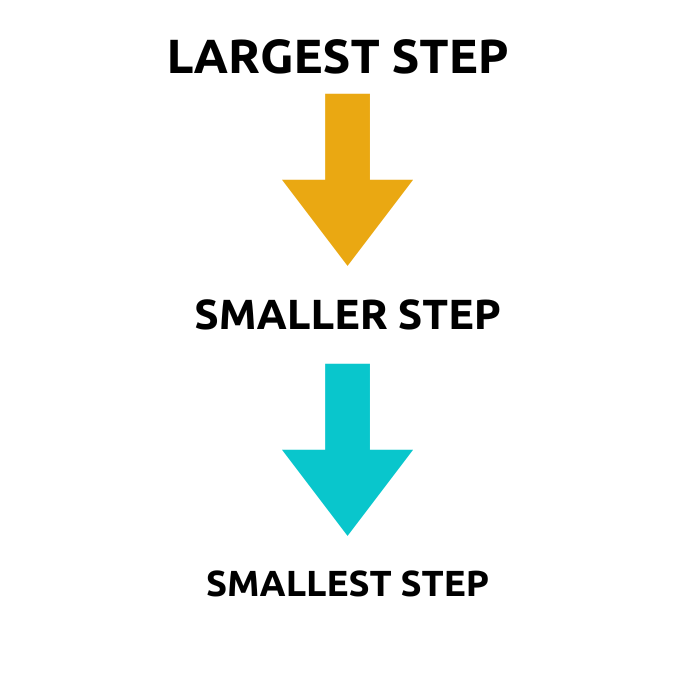
What’s your action plan to achieve your goals? (Crickets? Let’s make one.)
KEY TAKEAWAY: To achieve a goal, you need to have an action plan you can and will implement. Support that by starting with a goal that resonates with you and is defined enough to achieve. Create an action plan that fits you, defining what you’ll do, when, and how you will best support yourself as you take action. Scroll down to explore the TAKE ACTION section for this week’s actionable steps.
Want to know one of the biggest lessons I’ve learned personally and professionally over the years?
The best plan is the one you’ll actually implement.
I can hear you thinking, “Duh.”
I know. I know. But here’s the thing. While it seems obvious, how often have you planned to do something but didn’t? How many times have you created a great-on-paper plan that never saw the light of day? How often have you seen someone or an organization create great plans that don’t come to fruition?
I can’t answer for you, but my answer is A s—-load. I’ve seen many plans – including my own – that did not become a reality. Or were started but fizzled out.
After all, creating a plan is almost as satisfying as ticking off a to-do list item (sometimes, I will write down something I completed just to get the satisfaction of crossing it off). We feel like we’re actually doing something when we create a plan. We feel productive. It’s almost as if the thing we are planning to do was already done.
Unfortunately, there is a lot of room between “almost” and “done.”
So, how do you create a goal-achieving action plan that you will follow through on to achieve your goal?
Before Your Start: Ensure You Have Set the Right Goal
You want to set your goal, but not just any goal. The right goal for you. We discussed this in Ready to put your stake in the ground? Help ensure you are setting the right goal by asking yourself if your goal ticks the following boxes:
[ ] It is your goal, meaning that it is something that you are vested in achieving, as opposed to it being a goal that looks good on paper or someone else tells you that you “should” want to achieve.
[ ] It (still) fits you. You know your WHY for pursuing this goal, and it is a WHY that is still relevant. It’s not a goal that has become a habit, a carryover from another season in your life, but one that will help you to achieve a feeling that is still important for you to feel and that you don’t feel now.
[ ] It is a goal defined enough for you to identify and take specific actions to achieve it.
[ ] It is timebound. Your goal has a clear timeframe for when you’ll achieve it, or if it’s more of a process (for example, cultivating inner peace), you have set check-in points for assessing your progress.
[ ] It is measurable. You’ve identified a way to measure your progress, which supports you and your progress (vs. feeling like a punishment). For example, I don’t weigh myself because I find that a number reflected on a square metal box on the floor cannot accurately measure how good I feel, but it certainly can feel like a punishment if it doesn’t give me the number I want or expect.
Once you have the right goal, then create your action plan.
Step 1: Identify the Actions to Achieve Your Goal
Brainstorm all the actions you need to take to achieve your goal.
Then, break them down into as small steps as necessary for you to follow through.
Breaking down your actions into baby steps can help you avoid a sense of emotional—as well as practical—overwhelm, maintain your motivation, and follow through. This is important because most goals are generally not achieved by doing just one action but many, so find those “many actions” you can do and keep doing.
As you identify actions to take, try to make it easy for yourself to follow through. One way is to break down actions into smaller, more doable actions. You can also ask yourself what else will make it easier to follow through. If you find certain tasks more difficult or intimidating, what will make them less so? Can you change your approach or ask for help from someone else?
Step 2: Identify What You Need to Take Action
Identify what you need to take action and consistently take action. Identify and secure the resources or support systems to help you take consistent action and navigate obstacles. Be willing to ask for help. If you tend to go it alone, rely on what you know when finding out more or reaching out to someone who has done what you want to do could be beneficial, or otherwise limit your ability to achieve your goals by not having the information, support, or other resources you need, then change your approach.
Think about what resources could help you achieve what you want and then get them. As part of that, consider what people you want to involve or surround yourself with who will support you as you take action to achieve what you want, whether in the form of specific action or encouragement, advice, and/or accountability.
Step 3: Prioritize Your Actions
You can’t do everything at once and trying to do so will just lead to feeling overwhelmed. Achieving your goal demands focus. It demands your resources. You work with the time, energy, and financial resources you have, none of which are unlimited. So, prioritize what you need to do to avoid overwhelm and ensure that you focus yourself and your resources on what is most critical to achieving your goal. As you complete one task, then you can focus on another. First things first.
Step 4: Set a Deadline for Each Action
Step 5: Monitor Your Progress & Adjust As You Go
Monitor your progress as you go. Schedule regular check-ins to see how you’re doing. As you do, keep an open mind. If you’re not making progress, ask yourself why not. What is working? What is not? Be willing to pivot. Do you remember Einstein’s definition of insanity? It is “Doing the same thing over and over again and expecting a different result.” Are you repeating what isn’t working, and if so, what do you need to do differently going forward?
As part of monitoring your progress, be sure to celebrate milestones along the way to achieving what you want. Remember that this is a journey to what will help you achieve how you want to feel and what you want in your life. In other words, this is a gift that you are giving to yourself. So, help ensure it keeps feeling like a gift by acknowledging and celebrating your achievements along the way.
And then?
OTHER WAYS TO HELP YOURSELF: ALIGN & REALIGN YOUR MINDSET
As you implement your action plan, monitor your mindset. Is it on board with what you want to achieve? Is it helping or working against you? If it’s not as aligned as you need it to be, what can you do to support a more positive mindset?
As part of that, think about the following:
Do you have unrealistic expectations?
Unrealistic expectations of what you expect to achieve or the effort it will take can set you up to feel deterred or give up when your actual results fall short, or you encounter resistance along the way. So, set realistic expectations.
As part of that, expect to encounter headwinds as you work toward your goal and have a plan on how to navigate them. You will encounter obstacles. Internal ones, like fear, self-doubt, and feelings of not-enoughness. External ones, like other people or things, or practical ones, such as a finite amount of time, energy, and money. Be proactive, anticipating them and considering what strategies you can use to help you navigate them more effectively.
Are you resisting what isn’t comfortable?
Taking action to achieve something meaningful to you is uncomfortable. You care, which is uncomfortable because you risk getting hurt if you don’t achieve what you want. It is uncomfortable because you need to make a change, think, or act differently than you have to achieve your goal, which is uncomfortable.
So, expect discomfort. The good news is that outside of what is uncomfortable is something bigger: Magic. Potential. An opportunity to achieve more of how you want to feel and have in your life – your WHY. So, shift your mindset to embrace discomfort and the magic you can create in your life when you are willing to step outside your comfort zone to do so.
Are you beating yourself up when you don’t follow through?
If you’re not showing up consistently, ask yourself why. Don’t beat yourself up; instead, engage in compassionate self-inquiry. What is it about taking action that is hard? What is getting in your way? And what can you do differently to make it easier? What resources or sources of support can you access to help you take action? If you continue to not take action, ask yourself if you are sure that the goal you set is still the right one for you.
Are you getting stuck in old stories?
Are you stuck in what was or wasn’t, what did or didn’t happen, what you did or didn’t do, or old limiting beliefs of what you can or can’t do? To move forward toward what you want, let go of all of that. Let go of what was or wasn’t. Let go of what did or didn’t happen. Let go of regrets about what you did or didn’t do. Don’t worry about the tree you didn’t plant ten years ago. Now is the time for you to plant your tree.
It’s easy to look back and think, “How did I get here?” “Why me?” or other dead-end lament or regret. It’s easy to doubt ourselves or our lives in the shadow of perceived past mistakes. We can let them undermine our confidence in ourselves and our ability to achieve something different, now and in the future.
Let go of all that. Instead of looking back on it as something that detracts from what you can achieve, view it as a mountain of experience and knowledge that will propel you forward to help you achieve your goal. Embrace the following truth:
Your past does not define your future, but what you do now does.
TAKE ACTION:
- Start with the right goal. Your goal should be your goal, with a WHY that is meaningful to you and still relevant. You have defined your goal so that you can identify and take specific actions to achieve it. You have a timeframe for your goal and a measure to assess your progress in a supportive way.
- Identify the actions you need to take to achieve your goal. Brainstorm what you need to do, break it down into small actions, and make it as easy as possible to follow through.
- Identify what you need to take consistent action. Identify and secure the resources or support systems to help you take consistent action and navigate obstacles.
- Prioritize your actions to avoid overwhelm and focus yourself and your resources on what is most critical to achieving your goal.
- Set a deadline for each action and schedule it on your calendar.
- Monitor your progress as you go. Adjust what isn’t working and do more of what does. Celebrate milestones along the way.
Inspiration & information delivered to your inbox.
Receive FREE information, inspiration & support to help you feel more fulfilled, energized, and financially empowered in your life. Unsubscribe at any time.


0 Comments